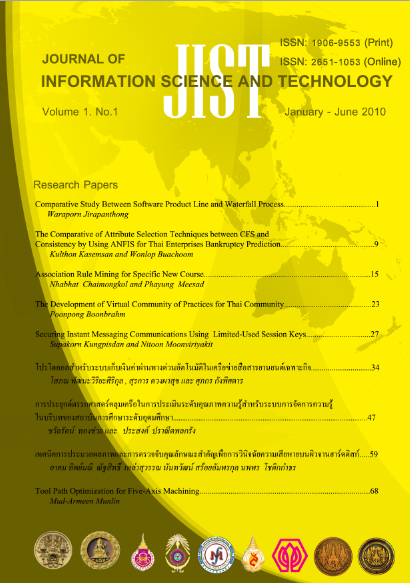A Protocol for Automatic Electronic Toll Collection System Based On VANET
Main Article Content
Abstract
- An automated electronic toll collection (AETC) system allows commuters to pay for a toll wirelessly while they are on the move. The type wireless network that facilitates the transactions between engaging parties in the AETC system is vehicular ad-hoc network (or VANET for short). It is clear that the transaction between a vehicle and the AETC must be performed in a secure and accountable manner. A number of payment protocols were developed to secure the AETC system. However, they still lack of necessary security and transaction performance. In this paper, we introduce a micropayment protocol for the AETC system that satisfies necessary transaction security properties. Moreover, our analysis shows that the proposed protocol has lower computation compared to the existing protocols. With the proposed protocol, engaging parties can complete each transaction faster than the existing approaches. This leads to better transaction performance.
Article Details
This work is licensed under a Creative Commons Attribution-NonCommercial-NoDerivatives 4.0 International License.
I/we certify that I/we have participated sufficiently in the intellectual content, conception and design of this work or the analysis and interpretation of the data (when applicable), as well as the writing of the manuscript, to take public responsibility for it and have agreed to have my/our name listed as a contributor. I/we believe the manuscript represents valid work. Neither this manuscript nor one with substantially similar content under my/our authorship has been published or is being considered for publication elsewhere, except as described in the covering letter. I/we certify that all the data collected during the study is presented in this manuscript and no data from the study has been or will be published separately. I/we attest that, if requested by the editors, I/we will provide the data/information or will cooperate fully in obtaining and providing the data/information on which the manuscript is based, for examination by the editors or their assignees. Financial interests, direct or indirect, that exist or may be perceived to exist for individual contributors in connection with the content of this paper have been disclosed in the cover letter. Sources of outside support of the project are named in the cover letter.
I/We hereby transfer(s), assign(s), or otherwise convey(s) all copyright ownership, including any and all rights incidental thereto, exclusively to the Journal, in the event that such work is published by the Journal. The Journal shall own the work, including 1) copyright; 2) the right to grant permission to republish the article in whole or in part, with or without fee; 3) the right to produce preprints or reprints and translate into languages other than English for sale or free distribution; and 4) the right to republish the work in a collection of articles in any other mechanical or electronic format.
We give the rights to the corresponding author to make necessary changes as per the request of the journal, do the rest of the correspondence on our behalf and he/she will act as the guarantor for the manuscript on our behalf.
All persons who have made substantial contributions to the work reported in the manuscript, but who are not contributors, are named in the Acknowledgment and have given me/us their written permission to be named. If I/we do not include an Acknowledgment that means I/we have not received substantial contributions from non-contributors and no contributor has been omitted.
References
2. D. Cottingham, I. Wassell, R. Harle, Performance of IEEE 802.11a in vehicular contexts, Proceedings of Vehicular Technology Conference, 2007, pp. 854–858.
3. Maxim Raya et al., “Security Aspects of Inter-Vehicle Communication”, IC-LCA, EPFL Switzerland, 2005.
4. J.T. Isaac et al., "A Secure Vehicle-To-Roadside Communication Payment Protocol In Vehicular Ad Hoc Networks" Computer Communications Vol 31(10), June. 2008, pp. 2478-2484.
5. K. Shin et al., "A Practical Security Framework for a VANET-based Entertainment Service," Proceedings of ACM PM2HW2N 09, Oct. 2009, pp. 175-182.
6. P. Papadimitratos et al., “Secure Vehicular Communication Systems: Design and Architecture,” IEEE Communications Magazine, vol. 46 (11), 2008, pp. 100-109.
7. F. Kargl et al., “Secure Vehicular Communications Systems: Implementation, Performance, and Research Challenges,” IEEE Communications Magazine, vol. 46(11), 2008, pp. 110-118.
8. E. Schoch et al., “Communication Patterns in VANETs,” IEEE Communications Magazine, vol. 46(11), 2008, pp. 119-125.
9. G. Kounga et al., “Generating CAauthenticated public keys in ad hoc networks,” Proceedings of ACM Mobicom 08, May 2008.
10. X. Lin et al., “TSVC: Efficient and Secure Vehicular Communications with Privacy Preserving,” IEEE Trans. Wireless Communications, vol. 7(12), 2008, pp. 4987- 4998.
11. U. Lee et al., “Dissemination and Harvesting of Urban Data Using Vehicular Sensing Platforms,” IEEE Trans. Vehicular Technology, vol.58(2), 2009, pp. 882-901.
12. U. Lee et al., “FleaNet: A Virtual Market Place on Vehicular Networks,” Proceedings of IEEE V2VCOM, Jul. 2006, pp. 1-8.
13. K. Plößl and H. Federrath, "A Privacy Aware And Efficient Security Infrastructure For Vehicular Ad Hoc Networks," Computer Standards & Interfaces Vol 30(6), Aug. 2008, pp. 390-397.
14. J. Abad-Peiro et al., Designing A Generic Payment Service, IBM Systems Journal 37(1), 1998, pp. 72–88.
15. S. Kungpisdan, A Secure Account-Based Mobile Payment System Protocol, Proceedings of International Conference on Information Technology: Coding and Computing (ITCC), 2004, pp. 35–39.


